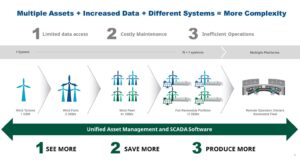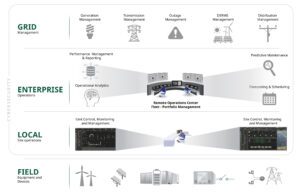Coming Clean: Strategies for Optimizing and Integrating a Renewable Energy Portfolio
By: Thomas Andersen, Emerson
A number of forces globally are in play that are sharply accelerating renewable energy installations. Of course, this move toward renewables was already well in motion as governments and businesses have looked for ways to meet their ambitious sustainability targets, including net zero. However, more recently, there has been added urgency.
Geopolitical uncertainties are sharpening the focus on domestic energy supply and the need for alternative energy sources, and this is further accelerating renewable energy investments made by governmental bodies in geographies across the globe. Cost also is an important factor: Renewables are becoming a more attractive option as the price gap between traditional fuels and renewables shrinks.
As these forces converge, the world is set to add as much renewable power in the next five years as it did in the past 20, according to IEA (International Energy Agency). In its March 2023 report, “CO2 Emissions in 2022,” the organization states that 90% of last year’s global growth in electricity generation was met with renewables, with solar photovoltaic (PV) and wind generation each increasing by approximately 275 TWh—a new annual record.
Clearly, for multiple reasons, renewables are all the rage. However, our increasing reliance on clean energy comes with its own set of challenges.
The first challenge pertains to the inherent nature of working with intermittent power sources. There is a need to balance the supply of clean energy with overall demand when the sun is not shining and the wind is not blowing. The industry is responding by implementing hybrid energy systems to help optimize the integration of renewable energy. Adding energy storage, such as utility-scale lithium-ion batteries, to solar or wind generation provides a consistent and continuous source of power, transforming variable sources into reliable, dispatchable generation. As such, this new hybrid model plays an important role in dialing up grid reliability and resiliency.
The second challenge relates to the physical footprint of renewables. Traditional fossil fuel plants have equipment housed under one roof, often with a common automation platform that provides valuable insights into numerous processes and equipment. In contrast to the traditional power plant model, renewable energy is typically generated by dozens or even hundreds of geographically dispersed power sources.
Individual renewable units or arrays, clusters of similar assets or fleets of green assets, typically operate with equipment from multiple manufacturers and are managed by a variety of control and monitoring automation technologies. Frequently, these automation technologies are of varying vintages and from different vendors. As such, these systems don’t easily integrate, which limits the data access that is necessary for providing a broad view of operations.
The inability to easily integrate assets and share data creates unnecessary complexity which, in turn, results in slower, inefficient decision-making. Maintaining multiple systems can also be time-consuming and costly. This is particularly true on the SCADA or asset-management level, where a unified view of operations is needed to manage a portfolio of renewable generation and energy storage assets efficiently and cost-effectively. This becomes even more problematic when integrating clean energy with other assets to provide a comprehensive view of a utility’s generating portfolio.
It’s evident that without a clear, broader view of operations, it is difficult—at best—for power producers to optimally manage renewable (and traditional) assets and, consequently, maximize their return on investment.

Image 1. With the growth of a renewable portfolio comes ever-increasing complexity. Applying a single, unified asset management and SCADA solution decreases complexity, enabling owners and operators to see more data, save on maintenance costs and produce more energy.
Unified View Maximizes Performance, Production and Profitability
Overcoming these hurdles requires a software solution—backed by deep expertise—that can gather, contextualize and securely deliver real-time and historical asset data to key stakeholders, providing them with accurate, actionable intelligence that enables better decision-making resulting in greater annual production and higher revenues. This approach, while deceptively simple in theory, has been elusive. Until now.
Fortunately, there is an innovative solution that puts this meaningful data at the fingertips of stakeholders. The solution was conceived by Emerson, a company steeped in deep power industry experience.
Emerson works with global power producers to navigate challenges and lead the transformation to a more intelligent power enterprise. The company recently made news, launching the Ovation™ Green portfolio as an extension of its power-based control architecture dedicated to renewable energy. By bringing together its software and automation platform, cybersecurity solutions, remote management capabilities and deep renewable energy knowledge base, Emerson offers customers a simplified solution for building and scaling sustainable operations.
The built-for-purpose software and technologies within Ovation™ Green leverage our decades of expertise to help organizations confidently solve their problems by advancing from a reactive approach to a predictive and prescriptive approach. Armed with valuable insights, it’s possible to accelerate data-driven decision-making, drive efficiencies and reduce costs. Furthermore, by providing an integrated, holistic view of operations from the field to the enterprise with clear visibility and situational awareness, power producers are better prepared for hard-to-predict events, resulting in more reliable generation and, subsequently, a more resilient and stable grid.
Fit-for-purpose renewable automation systems that provide a unified view of unfiltered real-time operational data from the field to the enterprise improve situational awareness and help to ensure that power producers are better prepared for hard-to-predict events.

Image 2. Put control of operations and maintenance back into the hands of owners and operators with an Ovation Green solution that provides a unified view of renewable operations from a single pane of glass.
Importantly, Emerson’s solutions are built for today … and tomorrow, offering a lifetime solution that continually evolves to allow for growth in a disciplined, balanced way and easily scales from a single asset to an entire portfolio.
Solutions for Renewable Asset Management and SCADA
As previously stated, maintaining multiple systems can be time-consuming, costly and negatively impact swift decision-making. This is particularly true on the SCADA or asset-management level, where a unified view of operations is needed to manage a portfolio of renewable generation and energy storage assets efficiently and cost-effectively.
Emerson’s Ovation™ Green renewable asset management and SCADA software mitigates the challenges related to clean energy complexity by providing a single pane of glass with clear operational visibility across the entire portfolio of sustainable energy generation and storage assets.
Harnessing and contextualizing the massive amounts of intelligent data generated by renewable assets not only ensures efficient and reliable operation at the site level but also at the fleet level, enabling utilities to make smart, informed decisions about how best to deploy multiple assets to meet both the energy needs of customers and the financial needs of the organization.
Secure, standardized access to a comprehensive set of centralized, unfiltered data at any time from anywhere provides greater insights into equipment health and optimization opportunities.

Image 3. Fit-for-purpose renewable automation systems that provide a unified view of unfiltered real-time operational data from the field to the enterprise improve situational awareness and help to ensure that power producers are better prepared for hard-to-predict events.
Smarter Tools to Achieve Goals
The power industry is making great progress toward sustainability, but more is needed to help organizations accelerate this critical transition to meet their goals while remaining competitive, maintaining grid reliability and continue delivering affordable energy to their customers.
To achieve objectives, power producers need smarter automation powered by a cohesive ecosystem of purpose-developed software supported by real expertise. Emerson is focused on enhancing our existing renewable strategies with smarter tools, such as the following, that will help our customers solve their evolving challenges:
- Built-in, software-defined cybersecurity protections and cyber analytics in anticipation of more frequent cyber attacks.
- Secure and interoperable multi-asset, multi-vendor SCADA and enterprise software.
- A single control and automation foundation of integrated software and technologies for aggregated grids including intelligent substations, distributed energy resources and EV chargers.
- Smarter software that can handle the complex and sometimes unpredictable tasks of energy trading, load shedding and virtual power plant management.
- Software that can monitor and control self-generating communities.
- Cloud computing with bundled application-specific software that allows for asset management at anytime from anywhere.
- Centralized remote operations and maintenance centers for fleet-wide management augmented by local, edge analytic software that is native to the automation platform.
- Pervasive use of an integrated, unified platform for advanced simulation and control that enables predictive and AI-driven maintenance strategies and enhanced operational decision-making.
Conclusion
As the growing integration of renewables with traditional energy sources continues to reinvent the power business model and infrastructure, Emerson remains committed to driving innovation not only in wind power, but in the broader renewable energy industry, as well. Areas of focus include: incorporating artificial intelligence (AI) and machine-learning technology into energy management and operating strategies, optimizing microgrids with wind generation and distributed energy resources, and enhancing grid support software to meet emerging grid operator requirements.
Looking ahead, as the demand for sustainable energy sources continue to rise and more green power options are developed, Emerson will continue to support the industry with its innovative software and automation portfolio and technical expertise. Doing so will help pave the way to a future where renewable and reliable power is realized at scale as the power industry continues its transformation, resulting in a world that is healthier, safer, smarter and more sustainable.
# # #
For more information visit: www.Emerson.com/Ovation-Green
![]()
